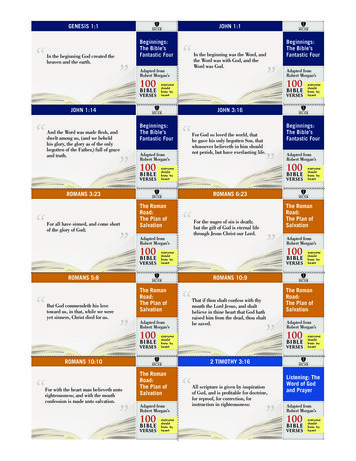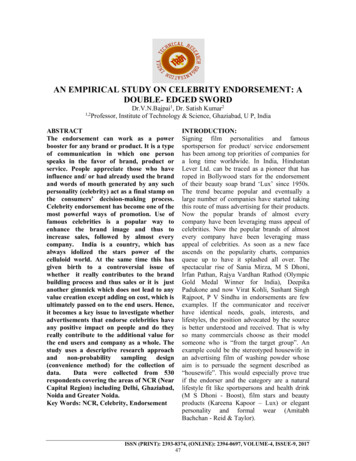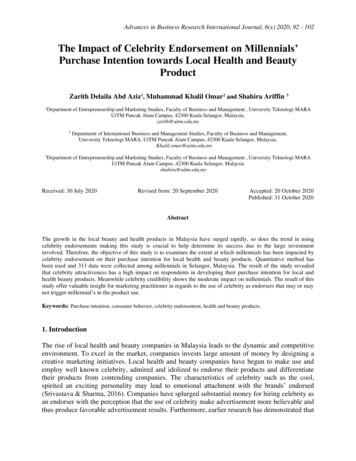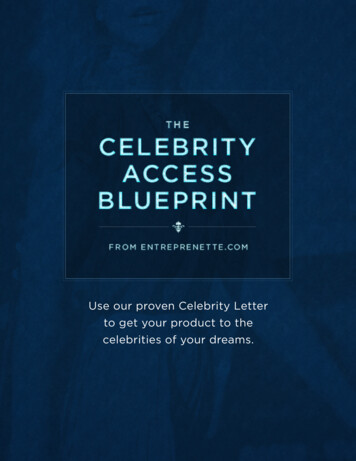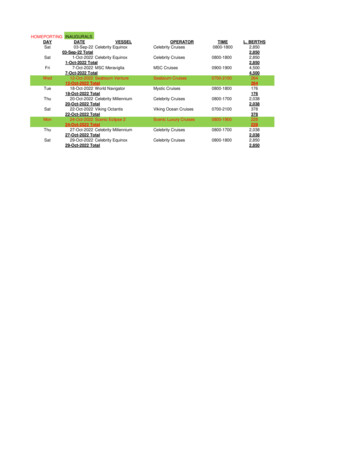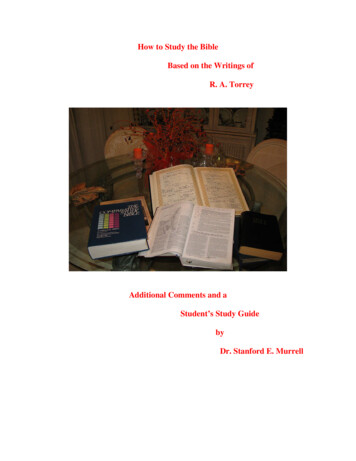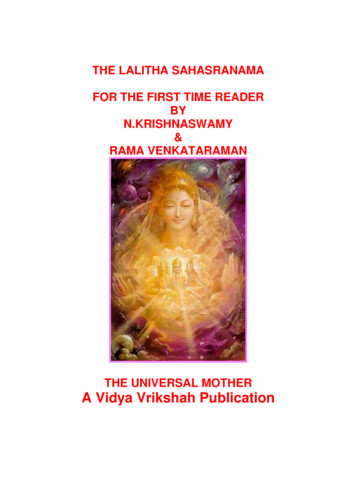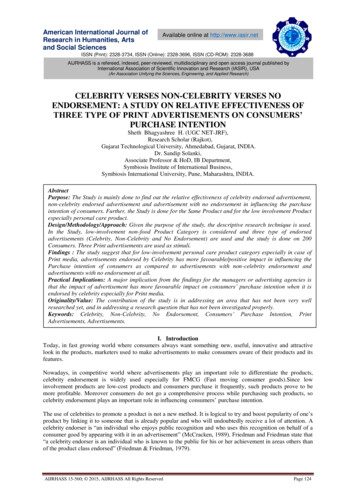
Transcription
American International Journal ofResearch in Humanities, Artsand Social SciencesAvailable online at http://www.iasir.netISSN (Print): 2328-3734, ISSN (Online): 2328-3696, ISSN (CD-ROM): 2328-3688AIJRHASS is a refereed, indexed, peer-reviewed, multidisciplinary and open access journal published byInternational Association of Scientific Innovation and Research (IASIR), USA(An Association Unifying the Sciences, Engineering, and Applied Research)CELEBRITY VERSES NON-CELEBRITY VERSES NOENDORSEMENT: A STUDY ON RELATIVE EFFECTIVENESS OFTHREE TYPE OF PRINT ADVERTISEMENTS ON CONSUMERS’PURCHASE INTENTIONSheth Bhagyashree H. (UGC NET-JRF),Research Scholar (Rajkot),Gujarat Technological University, Ahmedabad, Gujarat, INDIA.Dr. Sandip Solanki,Associate Professor & HoD, IB Department,Symbiosis Institute of International Business,Symbiosis International University, Pune, Maharashtra, INDIA.AbstractPurpose: The Study is mainly done to find out the relative effectiveness of celebrity endorsed advertisement,non-celebrity endorsed advertisement and advertisement with no endorsement in influencing the purchaseintention of consumers. Further, the Study is done for the Same Product and for the low involvement Productespecially personal care product.Design/Methodology/Approach: Given the purpose of the study, the descriptive research technique is used.In the Study, low-involvement non-food Product Category is considered and three type of endorsedadvertisements (Celebrity, Non-Celebrity and No Endorsement) are used and the study is done on 200Consumers. Three Print advertisements are used as stimuli.Findings : The study suggest that for low-involvement personal care product category especially in case ofPrint media, advertisements endorsed by Celebrity has more favourable/positive impact in influencing thePurchase intention of consumers as compared to advertisements with non-celebrity endorsement andadvertisements with no endorsement at all.Practical Implications: A major implication from the findings for the managers or advertising agencies isthat the impact of advertisement has more favourable impact on consumers’ purchase intention when it isendorsed by celebrity especially for Print media.Originality/Value: The contribution of the study is in addressing an area that has not been very wellresearched yet, and in addressing a research question that has not been investigated properly.Keywords: Celebrity, Non-Celebrity, No Endorsement, Consumers’ Purchase Intention, PrintAdvertisements, Advertisements.I. IntroductionToday, in fast growing world where consumers always want something new, useful, innovative and attractivelook in the products, marketers used to make advertisements to make consumers aware of their products and itsfeatures.Nowadays, in competitive world where advertisements play an important role to differentiate the products,celebrity endorsement is widely used especially for FMCG (Fast moving consumer goods).Since lowinvolvement products are low-cost products and consumers purchase it frequently, such products prove to bemore profitable. Moreover consumers do not go a comprehensive process while purchasing such products, socelebrity endorsement plays an important role in influencing consumers’ purchase intention.The use of celebrities to promote a product is not a new method. It is logical to try and boost popularity of one’sproduct by linking it to someone that is already popular and who will undoubtedly receive a lot of attention. Acelebrity endorser is “an individual who enjoys public recognition and who uses this recognition on behalf of aconsumer good by appearing with it in an advertisement” (McCracken, 1989). Friedman and Friedman state that“a celebrity endorser is an individual who is known to the public for his or her achievement in areas others thanof the product class endorsed” (Friedman & Friedman, 1979).AIJRHASS 15-560; 2015, AIJRHASS All Rights ReservedPage 124
Bhagyashree et al., American International Journal of Research in Humanities, Arts and Social Sciences, 11(2), June-August, 2015, pp.124-129Today, an Indian family used to read various newspapers and magazines per day. Moreover, each magazine andnewspaper includes various advertisements for different products. So, and they are exposed to around 1000 adsper day. The media-explosion can thus be easily demonstrated. Since, Print media is being considered as such apopular media in India through which one can reach large number of people at the same time, marketers usuallytend to choose Print media for their advertisements so as to aware more number of people about their productssimultaneously.Hence taking into consideration the above things the present study is undertaken to evaluate the impact ofCelebrity endorsement verses Non-Celebrity endorsement in Print advertisements for low involvement productcategory.II. Objectives of the study1) To determine the relative effectiveness of celebrity endorsed advertisements, non-celebrity endorsedadvertisements and advertisements with no endorsement at all for low-involvement product on consumers’attitude towards advertisement.2) To examine the comparative influence of advertisements with celebrity endorsement, advertisements withnon-celebrity endorsement and advertisements with no endorsement on consumers’ attitude towards advertisedproduct.III. Literature ReviewKaikati3 (1987):- Researcher found from his research that celebrity endorsement is highly useful and fruitful forthe firm using the endorsement .Researcher found about five advantages of employing celebrities for endorsingthe various products. The advantages were celebrities ability of drawing attention to the brand by breaking theclutter, crisis management, brand repositioning, global marketing, and boosting of sales.McCracken2 (1989):- McCracken, through his research give the definition of celebrity endorser. According tohim, a celebrity endorser is an individual who enjoys public recognition and who uses this recognition on behalfof a consumer good by appearing with it in an advertisement. His research shown that in general celebrityendorsement influences the feelings of the consumers and can also influence the attitude consumers havetowards the advertisement and attitude towards the brands, which can increase the purchase intentions and,consequently, increase sales.Till and Shimp6 (1998):- Researchers through their research examine the potential impact of negativeinformation about a celebrity endorser on consumer’s evaluations of the endorsed product. They find that, whena consumer’s knowledge structure about the brand and/or about the celebrity is less than fully developed,negative celebrity information can have a significantly negative impact on consumer’s brand evaluation. Theyconclude that such endorsement relationships, which are full of potential benefits, are not without risk.Chung, Derdenger and Srinivasan1 (2012):- In this research the researchers investigated the economic worthof celebrity endorsements by studying the sales of endorsed products. For the purpose of research, researchersevaluated the sales of the golf balls endorsed by Tiger woods and the golf balls without endorsement. It wasfound that approximately an additional 1,416,000 Nike golf balls sold each month when Tiger Woods was undera Nike endorsement contract. Furthermore, an additional profit of 103 million was generated from TigerWoods‟ endorsement effect. This result was not only from existing customers switching to Nike but alsothrough a primary demand effect.Radha and Jija4 (2013):- In this research the researcher analyses the impact of celebrity endorsement on thepurchase decision of consumers. Through their research, they found that 45.5% respondents are able to recollectthe brand that is endorsed by the celebrity. 53% of respondents agree that celebrity endorsement helps them torecognize a product. 23% of respondents strongly agree that they will get a positive image if their favouritecelebrity endorses a product. 51% of the respondent’s state that film stars endorsements persuades thempersonally to purchase products.Rashid Saeed, Rimsha Naseer, Shazia Haider and Uzma Naz5 (2014):- The purpose of the research is toexplore the impact of celebrity & non – celebrity advertisement on consumers’ perception. Through analysis theresearchers found that celebrity advertisement has greater positive relation with consumer perception than noncelebrity advertisement.AIJRHASS 15-560; 2015, AIJRHASS All Rights ReservedPage 125
Bhagyashree et al., American International Journal of Research in Humanities, Arts and Social Sciences, 11(2), June-August, 2015, pp.124-129IV. Distinguishing features of the study:The previous studies undertaken have shown the relative effectiveness of celebrity verses non-celebrityendorsed advertisements on consumers’ purchase intention, while the present study analyses the relativeeffectiveness of celebrity, non-celebrity and no endorsement advertisements on consumers’ purchase intention.The Previous researches conducted the study for low and high involvement products, while the present researchstudy involves only low-involvement product and especially for print media.V. Research MethodologyTarget population:- Adult consumers of Rajkot.Place of Study:- The study was undertaken in the city of Rajkot, Gujarat, India.Type of Research:- Descriptive research. Since the aim of the study is to examine and analyze theperceptions, preferences and buying behaviour of consumers of Rajkot especially with respect to lowinvolvement product category. Research Hypothesis :- Hypothesis tested using the study are : H1:- There is a significant difference between advertisements endorsed by celebrity,advertisements endorsed by non-celebrity, and advertisements with no endorsement at all ininfluencing the consumer’s attitude towards advertisement. H2:- There is a significant difference between advertisements endorsed by celebrity,advertisements endorsed by non-celebrity and advertisements with no endorsement at all ininfluencing the consumer’s attitude towards the advertised product. Sampling Plani. Samples and their size:a) Consumers:- 200 adult consumers were considered for the study.b) Product Selected for Study: - Low-involvement product(Shampoo) specifically Pantene was selected.Advertisement with Celebrity, advertisement with non-celebrity and advertisement with no endorsement in it forPantene were selected in order to know the purchase intention of consumers.ii. Sampling Method: - Probability/Random sampling method was used for study. Sources of Data: - The research study employed both secondary and primary sources of data. The detailsare as under:a) Primary sources of Data: - Personal Interview and Mall Intercept.b) Secondary sources of Data: - Company related websites, Leading Magazines and Newspapers, CompanyReports, Research papers, books.VI. Findings of the studyThe study was undertaken in two phases. In 1st phase relative effectiveness of advertisement with celebrityendorsement, advertisement with non-celebrity endorsement and advertisement with no endorsement at all onconsumer’s attitude towards advertisement was analysed. In 2nd phase relative effectiveness of advertisementendorsed by celebrity, advertisement endorsed by non-celebrity and advertisements with no endorsement onconsumer’s attitude towards the advertised product was analysed.Dependent and Independent variablesTo conduct the study, three print advertisements are used as stimulus and thus they are considered asIndependent variables. One advertisement for low involvement product named PANTENE consist of celebrity,other advertisement consist of non-celebrity and the third advertisement consist of no endorsement. OneDependent variable named Consumer Purchase Intention was taken. To measure the purchase intention ofconsumers, two variables were studied, consumer’s attitude towards advertisement and consumer’s attitudetowards the advertised product.Three Print advertisements are given below: Figure 1:- Print Advertisements of Shampoo with celebrity endorsement, non-celebrity endorsement andno endorsement for the same product PANTENEAIJRHASS 15-560; 2015, AIJRHASS All Rights ReservedPage 126
Bhagyashree et al., American International Journal of Research in Humanities, Arts and Social Sciences, 11(2), June-August, 2015, pp.124-129Hypothesis-1: Comparative Analysis of effectiveness of advertisements endorsed by celebrity, advertisementsendorsed by non-celebrity and advertisements with no endorsement for Shampoo product PANTENE onconsumer’s attitude towards advertisement especially in case of Print media. For carrying out the above analysis, a sample of 200 adult consumers was taken. The product considered forstudy was Shampoo that consumers usually like to use to wash their hair. Before starting the experiment, the age and gender was noted down. Consumer attitude towardsadvertisement, a four-item scale, was measured on five point likert scale with five options on scale.Anchors used in this scale were: “attractive, appealing, convicting and credible“. The subjects were asked torate their opinion on five-point likert scale to measure the consumer’s attitude towards advertisement.After noting down the responses following hypothesis were developed and tested. H null1: There is no significant difference between advertisement endorsed by celebrity, advertisementendorsed by non-celebrity and advertisement with no endorsement in it in influencing the consumerattitude towards advertisement for the same product especially in case of print media. H alt1: There is a significant difference between advertisement endorsed by celebrity, advertisementendorsed by non-celebrity and advertisement with no endorsement in it in influencing the consumerattitude towards advertisement for the same product especially in case of print media.The responses of consumers were served as data for testing the above hypothesis. The resultant data wasanalyzed using the Repeated measures ANOVA test using SPSS software. The value of alpha was assumed tobe 0.05. The table that shows the output for the above hypothesis are given below.Table-1: Descriptive StatisticsMeanStd. titude31.8400.92666200Table-2: Multivariate TestsEffectValueAdvertisementsFHypothesis df Error dfSig.Partial EtaSquaredNoncent.ParameterObservedPowerPillai's lks' otelling's oy's 1.000Table-3: Pairwise ComparisonsMeasure:MEASURE 1(I)(J)Advertise AdvertisementsmentsMean Difference (I-J)12395% Confidence Interval for DifferenceStd. ErrorSig.Lower BoundUpper .772-1.120From the table-2, it is observed that the Sig. (significance value) in Wilks’ Lambda row is .000 which is lessthan 0.05 which reveals that the null hypothesis is rejected (i.e. there is a significant difference between meansof all three conditions).Next, from table-3, it is observed that the data is sufficient to say the advertisements (pair of data) are likely tobe different.And from table-1, it is observed that AdvertisementAttitude1 has highest mean (3.98) as compared toAdvertisementAttitude2 and AdvertisementAttitude3. Moreover, AdvertisementAttitude2 has mean (2.86)greater than the mean (1.84) of AdvertisementAttitude3.AIJRHASS 15-560; 2015, AIJRHASS All Rights ReservedPage 127
Bhagyashree et al., American International Journal of Research in Humanities, Arts and Social Sciences, 11(2), June-August, 2015, pp.124-129Thus, it can be concluded that there is a significant difference between advertisements endorsed by celebrity,advertisements endorsed by non-celebrity and advertisements with no endorsement at all in influencing theconsumer attitude towards advertisement for the same product especially in case of print media andAdvertisements endorsed by celebrity has more favourable impact as compared to advertisementsendorsed by non-celebrity and advertisements with no endorsement at all in creating positive attitudetowards advertisement.Hypothesis-2: Comparative Analysis of effectiveness of advertisements endorsed by celebrity, advertisementsendorsed by non-celebrity and advertisements with no endorsement for Shampoo product PANTENE onconsumer’s attitude towards advertised product especially in case of Print media. For carrying out the above analysis, a sample of 200 adult consumers was taken. The product considered forstudy was Shampoo that consumers usually like to use to wash their hair. Before starting the experiment, the age and gender was noted down. Consumer’s attitude towards theadvertised product, a four-item scale, was measured on five point likert scale with five options on scale.Anchors used in this scale were: “Suitability of Shampoo(ranging from unsuitable to suitable), Smooth andsilky Shampoo(ranging from strongly disagree to strongly agree), the Shampoo in the ad makes hairshinier(ranging from strongly disagree to strongly agree) and influence of Shampoo(ranging from negativeinfluence to positive influence on five point likert scale)“. The subjects were asked to rate their opinion onfive-point likert scale to measure the consumer’s attitude towards the advertised product.After noting down the responses following hypothesis were developed and tested. H null1: There is no significant difference between advertisement endorsed by celebrity, advertisementendorsed by non-celebrity and advertisement with no endorsement in it in influencing the consumerattitude towards the advertised product especially in case of print media. H alt1: There is a significant difference between advertisement endorsed by celebrity, advertisementendorsed by non-celebrity and advertisement with no endorsement in it in influencing the consumerattitude towards the advertised product especially in case of print media.The responses of consumers were served as data for testing the above hypothesis. The resultant data wasanalyzed using the Repeated measures ANOVA test using SPSS software. The value of alpha was assumed tobe 0.05. The table that shows the output for the above hypothesis are given below.Table-4: Descriptive StatisticsMeanStd. 37200Table-5: Multivariate TestsEffectValueAdvertisementsPillai's TraceWilks' LambdaFHypothesis df Error dfSig.Partial 98.000.000.642355.6041.000Hotelling's oy's 1.000Table-6: Pairwise ComparisonsMeasure:MEASURE 1(I)(J)Advertise AdvertisementsmentsMean Difference (I-J)12395% Confidence Interval for DifferenceStd. ErrorSig.Lower BoundUpper 6-.954AIJRHASS 15-560; 2015, AIJRHASS All Rights ReservedPage 128
Bhagyashree et al., American International Journal of Research in Humanities, Arts and Social Sciences, 11(2), June-August, 2015, pp.124-129From the table-5, it is observed that the Sig. (significance value) in Wilks’ Lambda row is .000 which is lessthan 0.05 which reveals that the null hypothesis is rejected (i.e. there is a significant difference between meansof all three conditions).Next, from table-6, it is observed that the data is sufficient to say the advertisements (pair of data) are likely tobe different.And from table-4, it is observed that ProductAttitude1 has highest mean (4.28) as compared to ProductAttitude2and ProductAttitude3. Moreover, ProductAttitude2 has mean (3.68) greater than the mean (2.38) ofProductAttitude3.Thus, it can be concluded that there is a significant difference between advertisements endorsed by celebrity,advertisements endorsed by non-celebrity and advertisements with no endorsement at all in influencing theconsumer attitude towards the advertised product especially in case of print media and thus Advertisementsendorsed by celebrity has more favourable impact as compared to advertisements endorsed by noncelebrity and advertisements with no endorsement at all in creating positive attitude towards theadvertised Product.Final Conclusion:From the overall analysis, it can be concluded that the advertisements endorsed by Celebrity leads to higherconsumer purchase intention as compared to advertisements endorsed by Non-Celebrity and advertisementswith No Endorsement at all.VII. Limitations of the study & scope of future research(a)The study evaluated the impact of celebrity verses non-celebrity verses no endorsement in the Printadvertisement for one product only namely PANTENE Shampoo. But the same impact could also be evaluatedfor other products like corn flakes, biscuits, wafers etc.(b)The select group of products, Celebrities and ages sampled limit the degree to which these findings can begeneralized.(c)The celebrity considered in the study especially for created Print advertisements was popular celebrity but itmay happen that they may not be the favourite celebrity of consumer and hence this inconsistency may haveaffected the responses for products taste assessment and product liking. VIII. Policy Recommendation and Concluding remarksThe study revealed that an advertisement endorsed by celebrity has significant impact in creating positiveattitude towards advertisement. This information suggests that if advertisers of products make use ofcelebrity endorsement for advertising their products then they are likely to get their desired impact andappropriate reach for the money spent. The study also revealed that an advertisement endorsed by celebrity is more influential in developingpositive attitude of consumers towards the advertised product. This information suggests that if advertisersof products make use of celebrity for endorsing the products then they would be able to increase the sales ofthe endorsed products and thereby increasing the profits.Thus, the study shows that the advertisement with celebrity endorsement has more positive impact ininfluencing the purchase intention of consumers.References[1][2][3][4][5][6]Chung , K.Y., Derdenger, T.P., and Srinivasan, K., (2012). Economic Value of Celebrity Endorsements : Tiger Woods impact onsales of Nike Golf Balls, Carnegie Mellon University (Unpublished Work).Kaikati, J.G., (1987). Celebrity advertising: a review and synthesis, Journal of International Advertising, vol. 6, 93-105.McCracken, G., (1989). Who is the Celebrity Endorser? Cultural Foundations of the Endorsement Process, Journal ofConsumer Research, 16(3), 310-321.Radha G. and Jija P., (2013). Influence of Celebrity Endorsement on the Consumer’s Purchase Decision, InternationalJournal of Scientific and Research Publications, 3(11).Saeed R., Naseer R., Haider S. and Naz U., (2014). Impact of Celebrity and Non-Celebrity advertisement on ConsumerPerception, The Business and Management Review, 4(3), 154-160.Till, B. D. and Shimp, T. A. (1998). Endorsers in Advertising: The Case of Negative Celebrity Information. Journal ofAdvertising, 27(1): 67-82.AIJRHASS 15-560; 2015, AIJRHASS All Rights ReservedPage 129
Celebrity endorsement verses Non-Celebrity endorsement in Print advertisements for low involvement product category. II. Objectives of the study 1) To determine the relative effectiveness of celebrity endorsed advertisements, non-celebrity endorsed . For carrying out the above analysis, a sample of 200 adult consumers was taken. The product .
